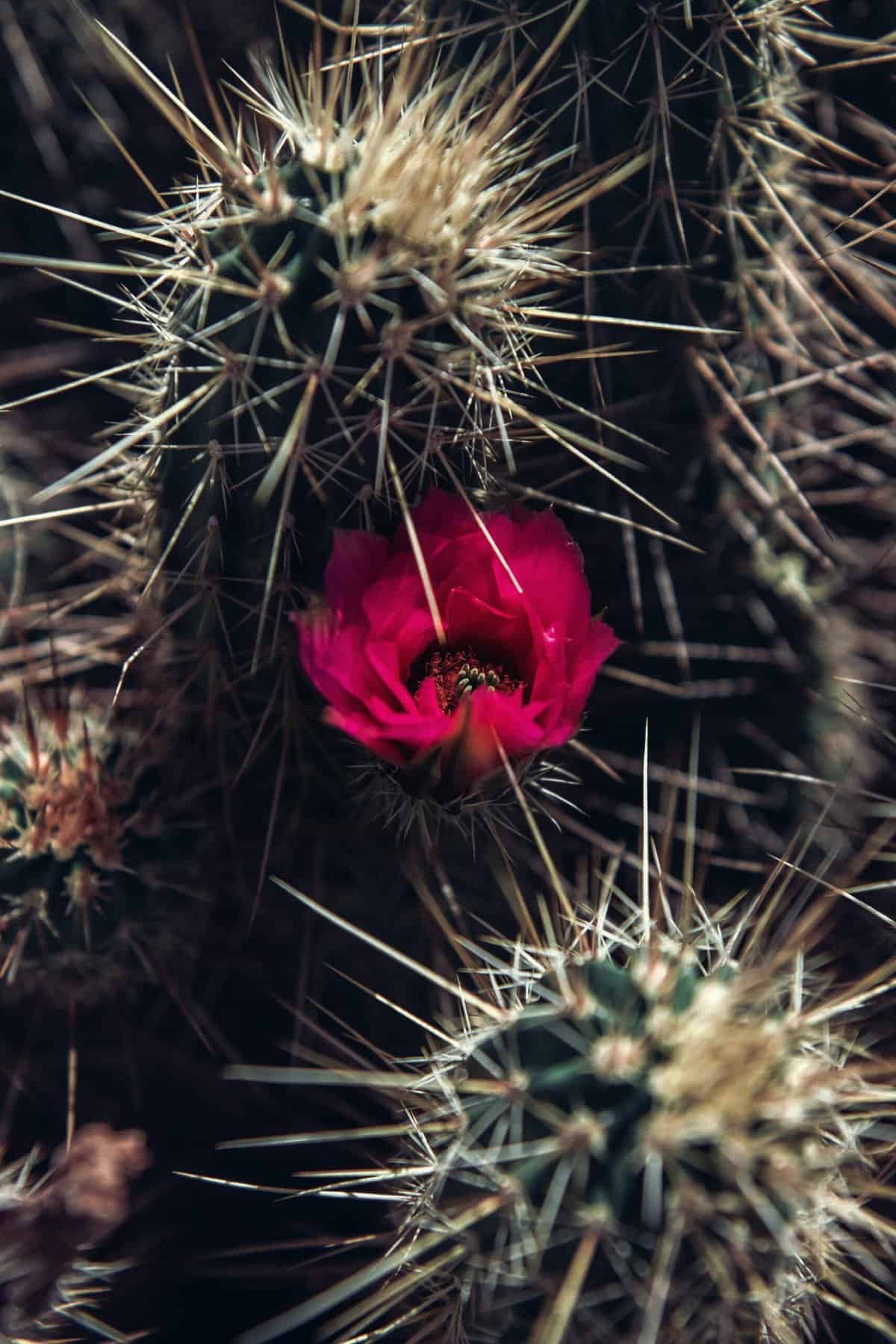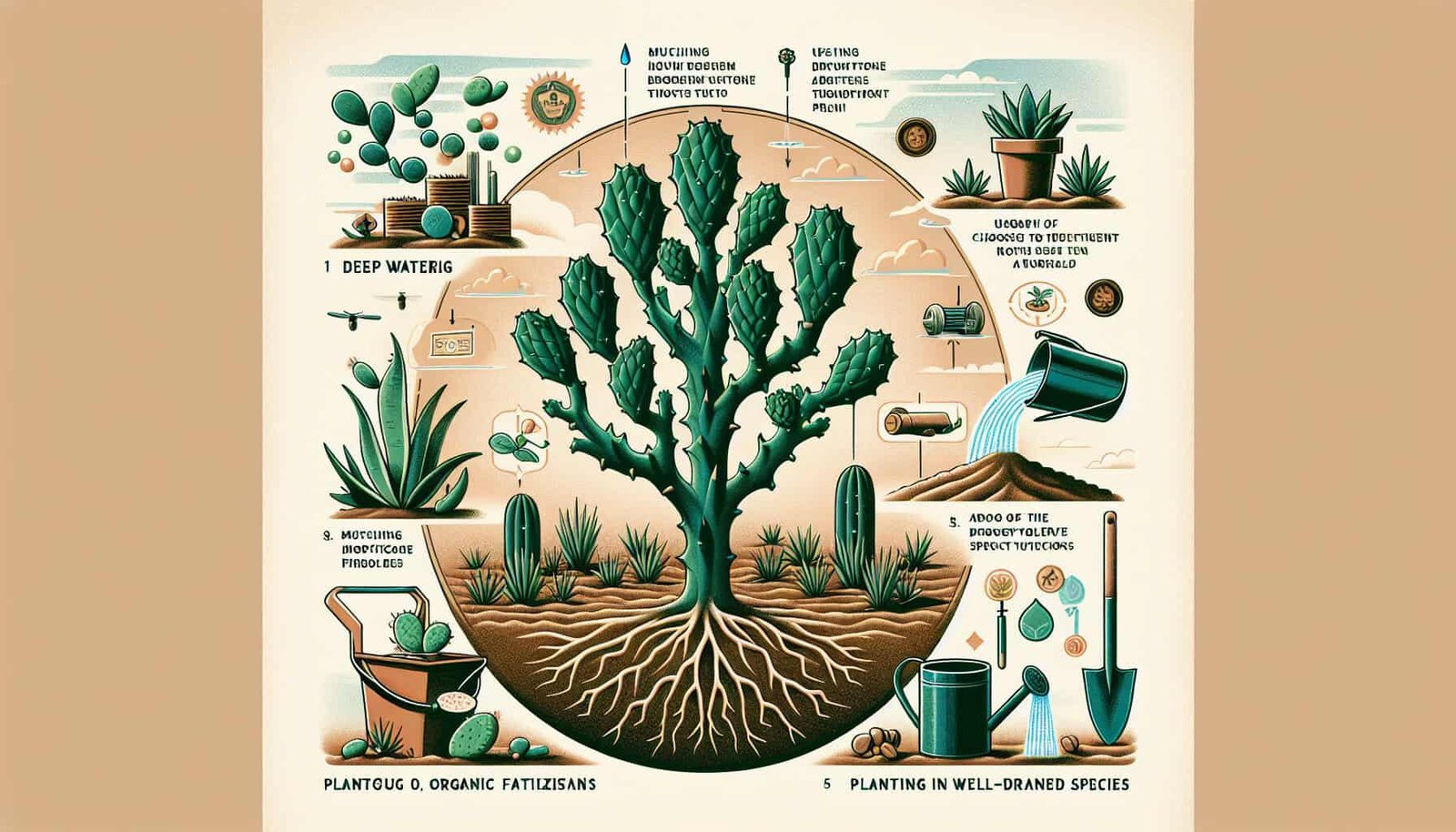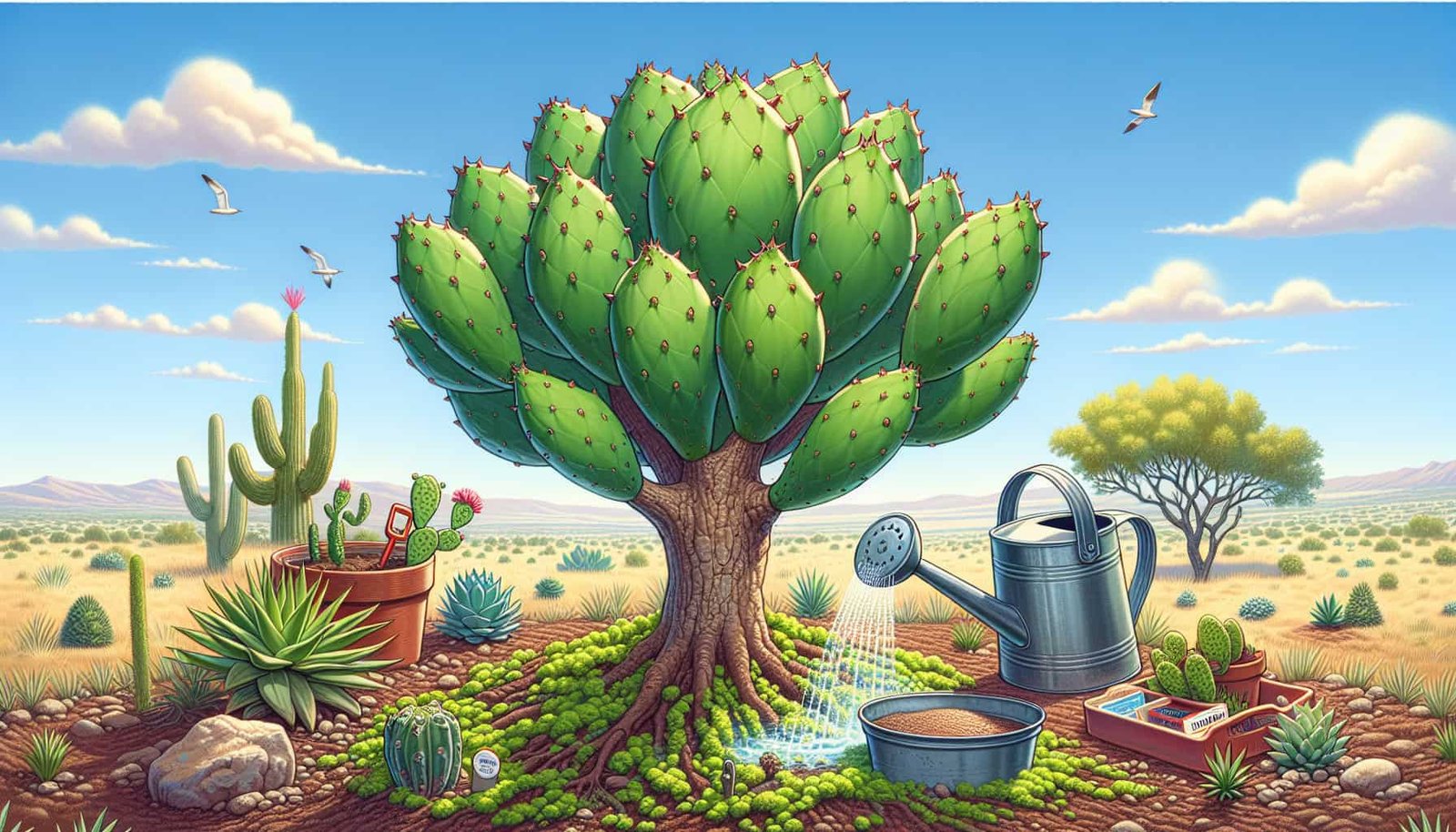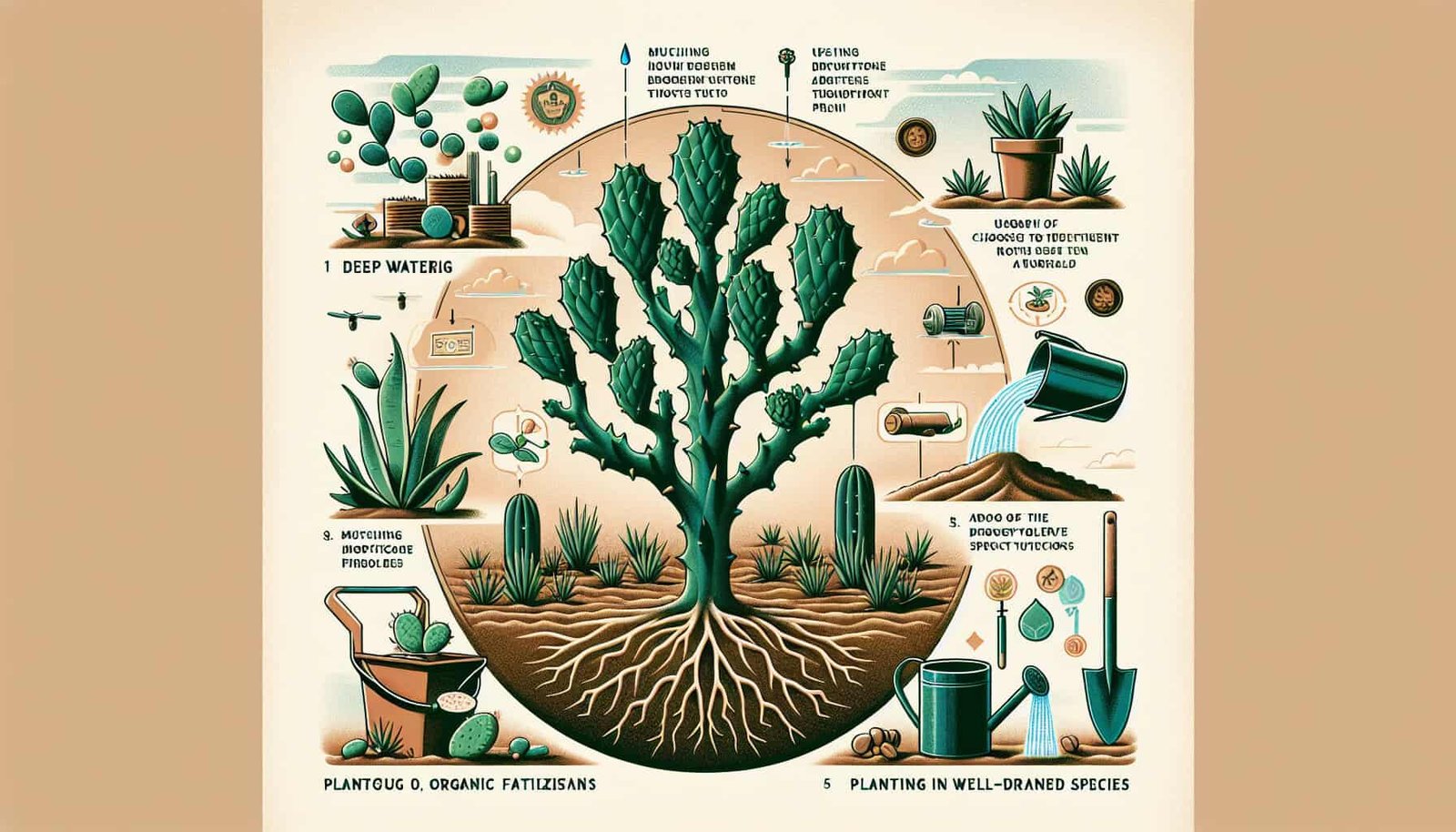Are you seeking ways to enhance nopal’s resilience to drought? Nopal, also known as prickly pear cactus, is a unique and valuable plant that thrives in arid climates. However, its ability to withstand prolonged periods of drought can be improved through a few simple techniques. By implementing proper watering strategies, incorporating organic matter into the soil, and providing adequate shading, you can help your nopal plants become more resilient and thrive even in dry conditions. So, let’s explore some effective methods to support the resilience of your cherished nopal plants!

Understanding the Nopal Plant
The Nopal plant, also known as the prickly pear cactus, is a fascinating and versatile plant that possesses numerous characteristics that make it well-suited for various agricultural applications. It is native to arid and semi-arid regions, particularly in Mexico and the southwestern United States. Understanding the basic characteristics of Nopal is crucial for optimizing its growth and resilience in different environmental conditions.
Basic Characteristics of Nopal
Nopal is a succulent plant that belongs to the Cactaceae family. It is characterized by its thick, fleshy, and flattened stems, which are covered with spines and glochids, small hair-like structures that can cause irritation upon contact. These spines and glochids serve as a natural defense mechanism to deter herbivores and prevent excessive water loss through evaporation.
One of Nopal’s most notable features is its ability to store water in its stems, allowing it to survive long periods of drought. This water storage capacity is essential for the plant’s resilience in dry environments, as it ensures a steady supply of moisture during periods of limited rainfall.
Nopal’s Importance for Agriculture
Nopal has traditionally been an important crop in regions with limited water availability, where it serves as a source of food, fodder, and industrial materials. It is rich in essential nutrients, including vitamins, minerals, and antioxidants, making it a valuable addition to the human diet.
Moreover, Nopal is also an excellent livestock feed due to its high fiber content and nutritional value. Animals such as goats and rabbits can graze on Nopal without harming themselves due to the presence of spines and glochids. Harnessing the potential of Nopal in agriculture can significantly contribute to food security and economic development in drought-prone regions.
The Impact of Drought on Nopal
Despite its remarkable ability to withstand drought, prolonged periods of water scarcity can still have a detrimental effect on Nopal’s growth and productivity. Insufficient water supply can lead to reduced photosynthesis, stunted growth, and decreased fruit production.
During periods of drought, Nopal will allocate its limited water resources primarily for essential physiological functions, such as maintaining turgidity and sustaining vital metabolic processes. As a result, the plant may prioritize survival over growth and reproductive activities, leading to a decrease in overall productivity.
Understanding the factors that affect Nopal’s resilience to drought is essential for implementing effective strategies to enhance its adaptability and productivity in arid environments.
Factors Affecting Nopal’s Resilience
Several factors play a crucial role in determining the resilience of Nopal plants to drought. By understanding these factors, growers can make informed decisions and implement appropriate management practices to optimize Nopal’s growth and productivity in water-limited conditions.
Genetic Variability of Nopal
The genetic variability of Nopal plants is a significant factor influencing their ability to withstand drought. Different cultivars and varieties of Nopal may exhibit varying levels of tolerance to water scarcity. By selecting and cultivating genetically resilient varieties, growers can increase the chances of successful Nopal production in drought-prone areas.
Root System Development
The development of a robust and extensive root system is crucial for Nopal’s ability to access water and nutrients in the soil. Nopal plants with well-established root systems can explore a larger volume of soil, enhancing their chances of finding moisture during drought periods. Proper soil preparation and cultural practices that promote strong root development, such as appropriate spacing and reduced competition from weeds, are essential for optimizing Nopal’s drought resilience.
Water-Efficient Traits of Nopal
Nopal possesses several water-efficient traits that enable it to conserve and make the most of limited water resources. Its thick, waxy cuticle on the stems and leaves minimizes water loss through transpiration. Additionally, the plant’s ability to close its stomata, tiny openings on the leaf surface, during periods of water stress helps reduce water loss through evaporation. These water-conserving mechanisms contribute to Nopal’s resilience and enable it to maintain growth and productivity during drought conditions.
Soil Management Techniques
Implementing appropriate soil management techniques is crucial for optimizing Nopal’s growth and resilience to drought. Adequate soil preparation, improving soil structure, and mulching can significantly contribute to Nopal’s ability to withstand water scarcity.
Adequate Soil Preparation
Before planting Nopal, it is essential to prepare the soil properly. This includes removing weeds and loosening the soil to facilitate root penetration and improve water infiltration. Adding organic matter, such as compost or well-rotted manure, can enhance soil fertility and moisture-holding capacity, providing a favorable environment for Nopal growth.
Improving Soil Structure
Ensuring the soil has good structure is vital for maximizing water retention and minimizing runoff. Nopal thrives in well-drained soils, and improving soil structure can help prevent waterlogging, which can be detrimental to the plant’s health. Techniques such as incorporating organic matter, avoiding over-tilling, and implementing conservation tillage practices can contribute to the development of a well-structured soil that promotes Nopal’s resilience to drought.
Mulching to Retain Moisture
Applying mulch around Nopal plants can significantly help retain soil moisture by reducing evaporation and preventing weed growth. Mulch acts as a protective layer that keeps the soil cooler and reduces water loss through evaporation. Organic materials, such as straw or wood chips, make excellent mulching materials and also contribute to the overall fertility of the soil.
Water Management Strategies
Efficient water management is critical for maximizing Nopal’s resilience to drought. Implementing appropriate irrigation techniques, establishing a watering schedule, and harnessing rainwater harvesting methods can help optimize water use and minimize water stress.
Irrigation Techniques
Selecting the appropriate irrigation technique is essential to ensure efficient water delivery to Nopal plants. Drip irrigation, for instance, is a highly efficient method that delivers water directly to the plant’s root zone, minimizing water loss through evaporation and runoff. It allows growers to provide sufficient moisture to Nopal while conserving water resources.
Watering Schedule
Establishing a watering schedule that aligns with the plant’s water requirements is crucial for Nopal’s resilience. While Nopal can withstand periods of drought, providing regular and adequate irrigation during critical growth stages, such as flowering and fruiting, is essential for optimal productivity. Monitoring soil moisture levels and adjusting the watering schedule accordingly can help prevent water stress and ensure the plant’s overall health and productivity.
Rainwater Harvesting
Harnessing rainwater through various techniques such as rain barrels or catchment systems can significantly contribute to Nopal’s resilience to drought. Collecting and storing rainwater allows growers to supplement irrigation during periods of water scarcity, reducing reliance on external water sources. Rainwater harvesting can be particularly useful in regions with irregular rainfall patterns, where every drop of water counts in sustaining Nopal’s growth and productivity.

Fertilization and Nutrient Management
Proper fertilization and nutrient management strategies are essential for maintaining Nopal’s health and maximizing its resilience to drought. Balancing fertilizer application, supplementing with organic matter, and identifying and correcting nutrient deficiencies are crucial aspects of nutrient management.
Balanced Fertilizer Application
Applying a balanced fertilizer that contains essential nutrients in the appropriate ratios is crucial for meeting Nopal’s nutrient requirements. Nitrogen, phosphorus, and potassium are the primary macronutrients necessary for plant growth and development. By conducting soil tests and assessing nutrient deficiencies, growers can tailor their fertilizer application to ensure optimal nutrition for Nopal.
Supplementing with Organic Matter
Incorporating organic matter, such as compost or well-rotted manure, can significantly contribute to Nopal’s nutrient availability and overall soil health. Organic matter enhances soil fertility, improves water-holding capacity, and promotes beneficial microbial activity, which can further support the plant’s resilience to drought. Applying organic matter as a mulch around Nopal plants can provide a slow-release source of nutrients and organic compounds, contributing to long-term plant health.
Identifying and Correcting Nutrient Deficiencies
Regular monitoring of Nopal plants for signs of nutrient deficiencies is crucial for timely intervention and corrective measures. Nutrient deficiencies can impair Nopal’s growth, reduce its ability to withstand drought, and impact overall productivity. Visual symptoms, such as yellowing leaves or stunted growth, can help identify nutrient deficiencies. By promptly addressing these deficiencies through targeted fertilization or appropriate nutrient supplementation, growers can support Nopal’s resilience to drought and ensure optimal plant health.
Pruning and Pest Control
Implementing proper pruning techniques and effective pest control measures are essential for optimizing Nopal’s growth and overall resilience.
Pruning Techniques to Optimize Growth
Pruning can help promote better resource allocation, enhance airflow, and optimize sunlight penetration, ultimately supporting Nopal’s growth and resilience. Removing dead or damaged stems, trimming excessive growth, and selectively thinning dense areas can improve the overall health and vigor of Nopal plants. However, it is important to ensure minimal interference with the plant’s natural form and structure, as Nopal’s unique characteristics contribute to its resilience.
Controlling Pest Infestations
Nopal plants are susceptible to various pests, including cochineal insects, aphids, and beetles. Infestations can weaken the plant, reduce growth, and impact overall productivity. Implementing integrated pest management strategies that combine cultural, biological, and chemical control methods can effectively mitigate pest populations and minimize damage to Nopal. Regular monitoring, early detection, and appropriate insecticide application, when necessary, are vital for effective pest control.
Preventing Diseases
Nopal plants may also be susceptible to certain diseases, such as bacterial or fungal infections. Implementing proper sanitation practices, including removing infected plant material and providing adequate airflow, can contribute to disease prevention. Additionally, employing disease-resistant Nopal varieties and ensuring optimal plant nutrition can enhance Nopal’s resilience to diseases. Regular plant inspections and timely intervention can help prevent diseases from spreading and impacting the overall health and productivity of Nopal crops.

Microclimate Modification
Creating favorable microclimates can significantly contribute to Nopal’s resilience to extreme weather conditions. Providing optimal shade, establishing windbreaks, and creating microclimates can help protect Nopal plants from excessive heat, wind, and other adverse environmental factors.
Providing Optimal Shade
Excessive heat and intense sunlight can cause stress and damage Nopal plants. Providing optimal shade, particularly during the hottest hours of the day, can help mitigate heat stress and reduce water loss through evapotranspiration. Implementing shading structures, such as shade cloth or trellises, can create a cooler and more favorable microclimate for Nopal, enhancing its resilience to drought and high temperatures.
Windbreak Establishment
Strong winds can cause physical damage to Nopal plants, disrupt water uptake, and increase water loss through transpiration. Establishing windbreaks, such as strategically planting larger vegetation or erecting windbreak fences, can protect Nopal crops from wind damage. Windbreaks help create a sheltered microclimate that reduces wind speed and minimizes water stress, contributing to increased resilience and overall plant health.
Creating Microclimates
In regions with extreme weather conditions, creating microclimates can be a valuable strategy for cultivating Nopal. By strategically placing Nopal plants in areas with natural or artificial microclimate modifiers, such as walls or slopes, growers can provide localized protection from adverse conditions. These microclimates can help retain moisture, reduce temperature fluctuations, and enhance Nopal’s resilience to drought and other environmental stresses.
Crop Rotation and Diversification
Incorporating crop rotation and diversification practices can contribute to Nopal’s resilience by promoting soil health, reducing pest and disease pressure, and enhancing overall system resilience.
Rotating Nopal with Resilient Crops
Including crop rotation in Nopal farming systems can help break pest and disease cycles, reduce weed pressure, and optimize nutrient cycling. By implementing a rotation sequence that includes Nopal and other resilient crops, growers can enhance soil health, minimize pest and disease incidence, and improve the overall resilience of their farming systems. The inclusion of leguminous crops in rotation can also contribute to nitrogen fixation and further support soil fertility.
Benefitting from Complementary Plants
Companion planting involves growing complementary plants alongside Nopal, enhancing beneficial interactions and optimizing resource use. Certain plants can act as natural pest repellents, provide shade or wind protection, or contribute to soil fertility through nitrogen fixation. For example, planting leguminous cover crops between Nopal rows can enrich the soil with nitrogen, supporting Nopal’s nutrient requirements and overall resilience to drought.
Enhancing Biodiversity
Promoting biodiversity within Nopal farming systems can significantly contribute to the plant’s resilience to drought and other environmental stresses. Encouraging the presence of diverse plant species, including native vegetation and beneficial insect habitats, can improve overall ecosystem stability, enhance pollination, and provide natural pest control. Maintaining hedgerows, establishing wildlife habitats, and avoiding excessive pesticide use are crucial practices that help conserve biodiversity and support Nopal’s long-term resilience.

Technology and Innovation
Harnessing modern technology and innovation can further enhance Nopal’s resilience to drought. Precision agriculture techniques, sensing and monitoring technology, and advancements in breeding and genetic engineering offer valuable tools to optimize Nopal production in water-limited environments.
Precision Agriculture Techniques
Precision agriculture involves using technologies such as remote sensing, satellite imaging, and Geographic Information Systems (GIS) to monitor and manage agricultural systems efficiently. By precisely mapping soil moisture levels, plant health, and nutrient status, growers can make informed decisions regarding irrigation, fertilization, and overall crop management. Implementing precision agriculture techniques can help optimize resource use, minimize water stress, and maximize Nopal’s resilience and productivity.
Sensing and Monitoring Technology
Advancements in sensing and monitoring technology, such as moisture sensors and weather stations, provide real-time data on soil moisture, temperature, humidity, and other environmental parameters. By continuously monitoring these variables, growers can make timely decisions regarding irrigation scheduling, shade provision, and other water and microclimate management practices. Sensing and monitoring technology enable growers to optimize water use, mitigate drought stress, and enhance Nopal’s resilience.
Breeding and Genetic Engineering
Breeding and genetic engineering techniques can enable researchers to develop Nopal varieties with improved drought tolerance and productivity. Through selecting and breeding plants with desired traits, such as increased water-use efficiency or enhanced nutrient uptake, scientists can develop Nopal cultivars tailored for specific environmental conditions. Genetic engineering also offers the potential to introduce genes that enhance drought tolerance or improve water-use efficiency in Nopal plants. These advancements in breeding and genetic engineering hold promise for further enhancing Nopal’s resilience to drought and supporting sustainable agriculture.
Community Involvement and Education
Community involvement and education play a crucial role in promoting sustainable Nopal production practices and enhancing the resilience of agricultural systems.
Sharing Knowledge and Best Practices
Sharing knowledge and best practices among Nopal growers, researchers, and agricultural extension services is vital for building collective expertise and fostering innovation. Educational programs, workshops, and farmer-to-farmer knowledge exchange initiatives can facilitate the dissemination of information, techniques, and strategies that enhance Nopal’s resilience. By pooling together experiences, learnings, and innovations, communities can collectively tackle the challenges posed by drought and contribute to the long-term sustainability of Nopal farming.
Encouraging Sustainable Production Practices
Promoting sustainable production practices, such as agroecology and organic farming, can contribute to Nopal’s resilience and overall environmental sustainability. These practices emphasize soil health, biodiversity conservation, reduced chemical inputs, and efficient resource use. By minimizing reliance on external inputs and optimizing ecological interactions, growers can enhance Nopal’s resilience while preserving the long-term health of ecosystems and water resources.
Promoting Collaborative Research
Collaborative research initiatives between scientists, growers, and other stakeholders can drive innovation and enhance the resilience of Nopal farming systems. By collectively identifying research priorities, sharing resources, and exchanging findings, collaborative research can provide practical solutions to challenges related to Nopal production under drought conditions. Research outcomes can inform evidence-based practices, improve genetic resources, and contribute to the overall sustainability and resilience of Nopal farming.
In conclusion, improving Nopal’s resilience to drought is critical for maximizing its growth, productivity, and sustainability in arid and semi-arid regions. By understanding the basic characteristics of Nopal, implementing appropriate management techniques, harnessing technological advancements, and promoting community involvement and education, growers can enhance Nopal’s adaptability and ensure its long-term success in water-limited environments. Through comprehensive efforts, Nopal can continue to thrive as a valuable crop supporting food security, economic development, and environmental sustainability.


